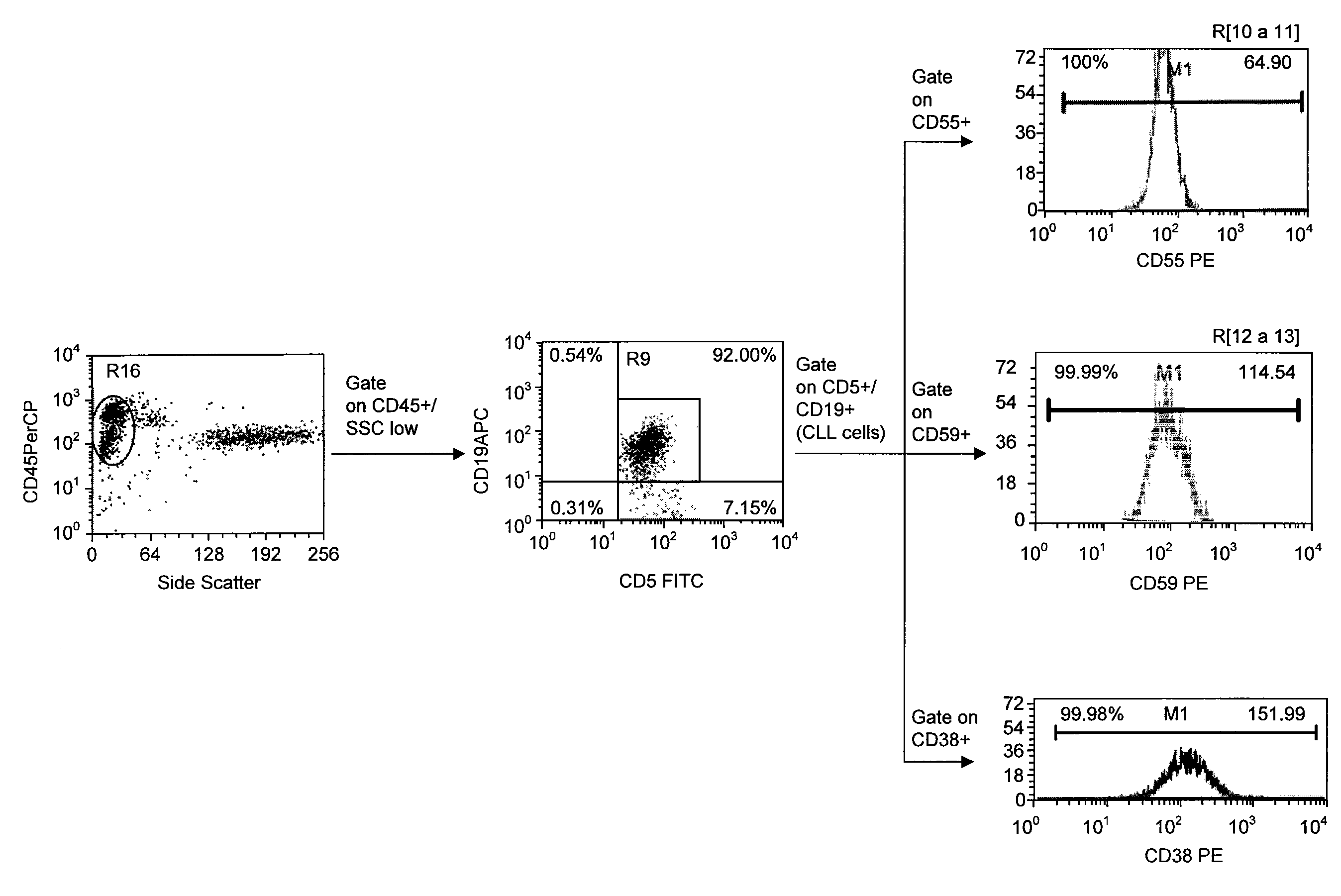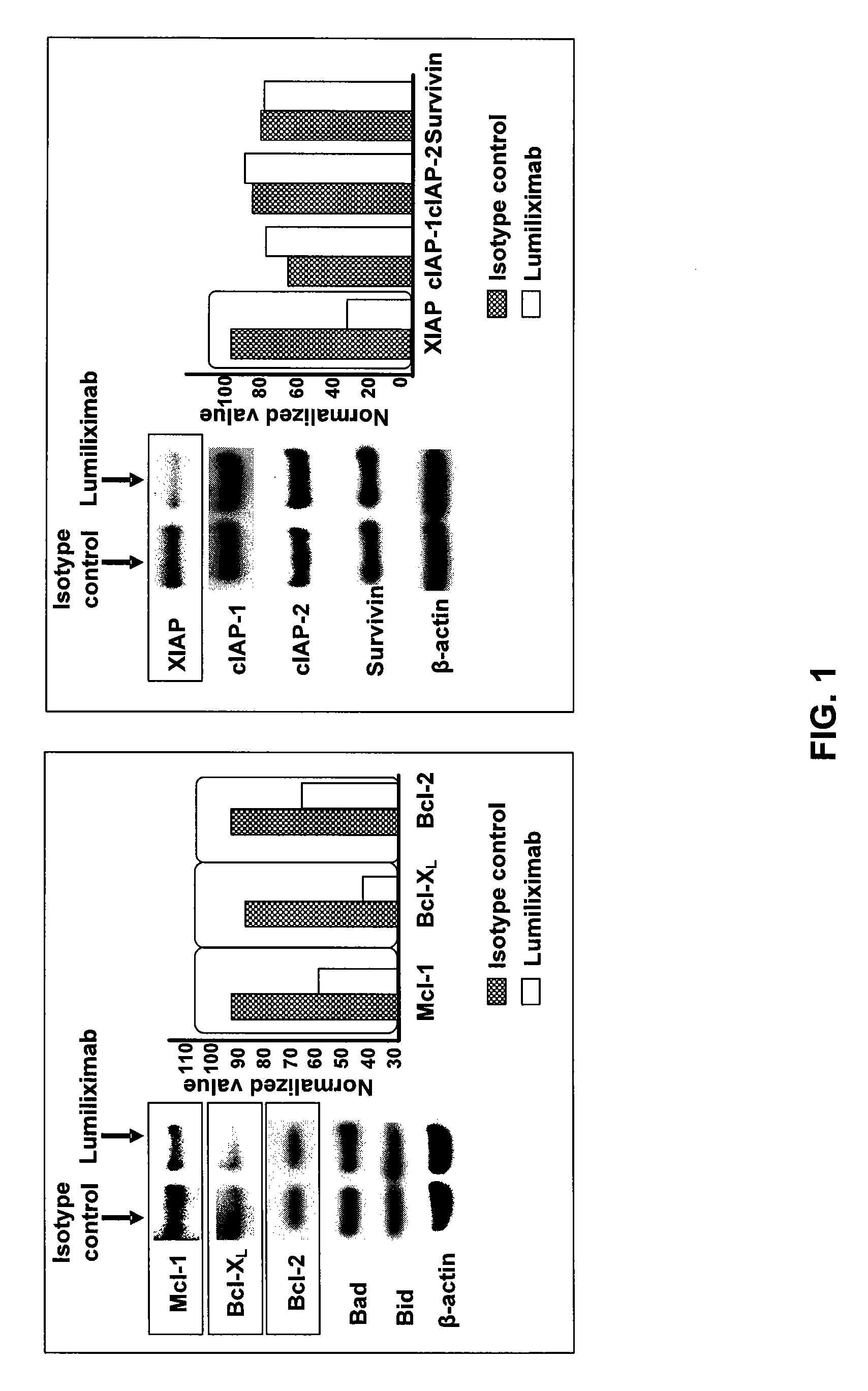Use of CD23 Antibodies to Treat Malignancies in Patients with Poor Prognosis
a technology of cd23 antibodies and malignancies, which is applied in the direction of antibodies, drug compositions, peptides, etc., can solve the problems of poor prognosis and ineffective treatment for patients with poor prognostic markers
- Summary
- Abstract
- Description
- Claims
- Application Information
AI Technical Summary
Benefits of technology
Problems solved by technology
Method used
Image
Examples
example 1
Tumor Burden in Patients Enrolled in 152-30 Study
[0178]In order to determine if lumiliximab, in combination with fludarabine, cyclophosphamide and rituximab (L+FCR) is effective in treating patients with poor prognosis, CLL cells were isolated from patients pre-treatment. The pre-treatment tumor burden as assessed by the number of CD5+ / CD19+ cells at screen in patients in the CR+PR group was not significantly different from those in the SD+PD group (p=0.8311; Wilcoxon Rank Sum test), suggesting that high tumor load did not have a negative impact on treatment outcome (FIG. 2A). In addition, the number of CD5+ / CD19+ cells progressively declined over the course of follow-up, starting from week 5 after treatment initiation, in both the CR+PR and SD+PD group (FIG. 2B). However, at weeks 5, 9, 13 and 21 after the initiation of treatment, the number of CD5+ / CD19+ cells were significantly lower in the CR+PR group compared to SD+PD group as predicted (p<0.05 for each week; Wilcoxon Signed Ra...
example 2
Lumiliximab Combination Treatment is Effective in Patients with High ZAP70 Expression
[0179]The CLL samples were used to determine the presence or absence of poor prognostic markers. For example, it has previously been shown that ZAP70 expression on at least 30% of CLL cells is associated with a poor prognosis. Therefore, the percentage of ZAP70+ CLL cells in the patient samples was measured using flow cytometry. Nine of the sixteen patients tested had more than 30% ZAP+ CLL cells. Patients were treated with L+FCR and their response was assessed. Patients were classified as complete responders (CR), partial responders (PR), stable disease (SD) or progressive disease (PD). The results are shown in FIG. 3A. Five of the nine patients with greater than 30% ZAP+ CLL were complete or partial responders. Interestingly, the five patients that responded well to treatment had greater than 60% ZAP70+ CLL cells.
[0180]After the inclusion of additional patients in the study, eighteen patients had ...
example 3
Lumiliximab Induces Apoptosis in ZAP70+ Cells
[0181]It is thought that lumiximab can induce apoptosis by activating caspases.
[0182]Therefore, in order to determine if lumiliximab can induce apoptosis in ZAP70+ cells, activation of caspase-3 in ZAP70+ cells was measured before and after treatment with lumiliximab. The results are shown in FIG. 4A. Expression of ZAP70 was assessed by western blots using antibodies against ZAP70, phosphorylated ZAP70 and β-actin as a control. ZAP70 expression was seen in all three patient samples tested, but levels of protein expression and phosphorylation varied between patients (see FIG. 4B). However, caspase-3 activity was higher two days after treatment than before treatment in samples from all three patients. These results indicate that lumiliximab can induce apoptosis in cells expressing ZAP70 and / or phosphorylated ZAP70.
PUM
| Property | Measurement | Unit |
|---|---|---|
| Fraction | aaaaa | aaaaa |
| Fraction | aaaaa | aaaaa |
| Fraction | aaaaa | aaaaa |
Abstract
Description
Claims
Application Information
 Login to View More
Login to View More - R&D
- Intellectual Property
- Life Sciences
- Materials
- Tech Scout
- Unparalleled Data Quality
- Higher Quality Content
- 60% Fewer Hallucinations
Browse by: Latest US Patents, China's latest patents, Technical Efficacy Thesaurus, Application Domain, Technology Topic, Popular Technical Reports.
© 2025 PatSnap. All rights reserved.Legal|Privacy policy|Modern Slavery Act Transparency Statement|Sitemap|About US| Contact US: help@patsnap.com



